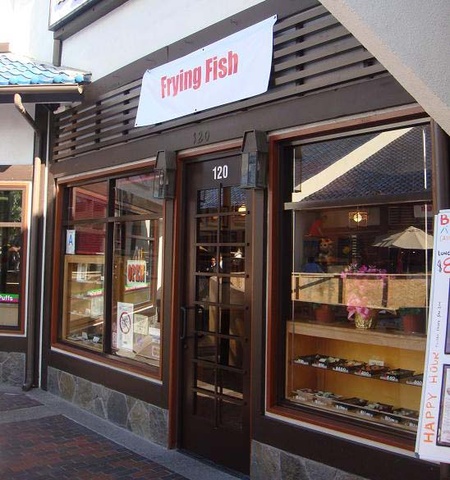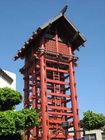Editor’s note: Discover Nikkei is an archive of stories representing different communities, voices, and perspectives. The following article presents the opinions of a Little Tokyo business owner and does not represent the views of Discover Nikkei and the Japanese American National Museum. Discover Nikkei publishes these stories as a way to share different perspectives expressed within the community.
“You cannot hold a tsunami by yourself.” These are the words of Mr. Akimoto as he ponders the future of Little Tokyo. His wife, Mrs. Akimoto, is the owner of Frying Fish, a kaiten-sushi restaurant in the center of Little Tokyo.
Mr. Akimoto, a sansei Japanese American with strong connections to the history of the neighborhood, feels there are many problems in Little Tokyo involving the steady decrease of Japanese American residents and the influx of Korean businesses. Yet, there have been no viable ideas for a revival of Little Tokyo and a way to bring back Japanese residents to the area. In response to such a situation, Mr. Akimoto believes there is little he can do to promote change in order to preserve the Japanese American culture in Little Tokyo. However, he is unable to desert the neighborhood he grew up in. His restaurant is not just a restaurant in the Little Tokyo shopping mall but a sit-in-protest to preserve Japanese American ownership in the area as well as a loving husband’s gift to his wife.
In an interview with Mr. Akimoto, he comments that there is little Japanese culture in Little Tokyo. He references a simple plan of his to commemorate Japanese traditions and celebrate festivities like Girl’s Day and Japanese New Years at the Frying Fish, but found that it would do no good since his restaurant would be the only one doing such activities in the shopping mall. He states that the third, fourth, and fifth generation don’t consider themselves as Japanese and have moved away from the neighborhood. He says that these generations perceive Little Tokyo as “no different than another shopping mall competing against other shopping malls.” Due to this view, many Japanese Americans saw suburbs as a more progressive method of life in America after World War II, causing a large part of the Japanese American community to move out of Little Tokyo.
Mr. Akimoto’s understanding of the history of the Little Tokyo neighborhood is as follows. By the 1960s, the Little Tokyo area had lost much of its Japanese American cultural background and was steadily being absorbed by Civic Center expansion. Mr. Akimoto states that Mr. Kajima, a leading member of the House of Representatives of the Japanese Diet and the chairman/CEO of Kajima Corporation, had spent his own money to help plan the rebuilding of Little Tokyo and the establishment of the Japanese consulate general building in the area. Mr. Akimoto believes that these efforts were made to bring Japanese Americans back to Little Tokyo.
Mr. Akimoto went on to explain that indeed, some Japanese did come back to Little Tokyo in this period. Japanese companies such as Honda created branches in Little Tokyo to begin international business. Yet, due to more convenient locations near the airport, these Japanese corporations moved out of Little Tokyo. Because these businesses began to leave, the Japanese American community decided to build a shopping mall complex to promote business in the area. However, due to fundraising problems, the intervention of the Community Redevelopment Agency of the City of Los Angeles (CRA) became necessary. Mr. Akimoto believes that through this, the ownership of Little Tokyo began to shift out of the hands of Japanese Americans.
A resulting debate in the present day of “outsiders” in Little Tokyo is the Korean ownership of businesses. Currently, almost half of the tenants in the shopping mall are Korean [Editor’s note: In an inventory survey of all of Little Tokyo businesses conducted this past year, 66% of the owners identified themselves as Japanese or Japanese American, 14% identified as Korean]. Yet, Mr. Akimoto states that the Korean movement into Little Tokyo is not as simply as it may seem. During World War II, many Koreans were brought back to Japan and were assimilated into Japanese society. These Koreans of Japanese descent immigrated to Los Angeles and with their Korean relatives began to do business in Little Tokyo. When looking at the history of the current Korean tenants, one can frequently find such Japanese Korean roots.
However, Mr. Akimoto argues that because these Koreans cannot speak Japanese, a cohesive community cannot be built even if they have a partial-Japanese background. Community group discussions and organizations have become complicated due to a clash between non-Japanese speaking Koreans and non-English speaking Issei Japanese immigrants. Differences in priorities of these clashing groups for the development of the Little Tokyo neighborhood have promoted much debate in the community.
In an effort to promote more Japanese residents in Little Tokyo, the Japanese American community was able to build the Little Tokyo Towers residential housing through their own fundraising. They believed the housing complex could be used by the Japanese for years to come. However, the present day occupants of the complex have become 60% Korean and the primary language used is Korean. Mr. Akimoto suspects that more Japanese will move out of Little Tokyo and the void will be filled in by Koreans of Japanese descent and their relatives. [Editor’s note: a 2009 survey conducted by the Little Tokyo Service Center showed that the make-up of residents to be 50% Japanese, 39% Korean, and 11% other]
Mr. Akimoto had been involved in community groups in the early stages of the development of Little Tokyo but gave up when the community members no longer had strong ties to Little Tokyo as he had. Compared to Chinatown community groups such as the Lee Family Association, there are no cohesive community groups in Little Tokyo. He believes that while other cultural communities groups strive to keep such cultural spirit alive, the Japanese American community has left behind such ideas in order to pursue a suburban life they view as more progressive. He comments that “it is a waste of time” for the Japanese people to discuss such topics on the preservation of Little Tokyo because they are simply not interested.
Mr. Akimoto however, has a strong interest in keeping Little Tokyo a Japanese American community. Though he was born in the US, his family arranged his marriage with a woman from Japan. Because his wife could not speak any English and was unaccustomed to American life, Little Tokyo presented a perfect environment for her. Mr. Akimoto hopes to preserve this Japanese American environment in order to sustain a neighborhood his wife would be comfortable in. Mr. Akimoto comments that she seems to be happy to be in Little Tokyo. She participates in community groups and is content with running the restaurant. He states that he has no interest in making money at the restaurant, and as long as they break even and his wife is happy, he is happy. Although Mr. Akimoto believes that he cannot hold back the tsunami of change in Little Tokyo, he hopes to stay put in order to preserve the Japanese American community in the neighborhood and live happily with his wife.
** Discover Nikkei partnered with Professor Morgan Pitelka of Occidental College and his students taking the Spring 2010 seminar “Japanophilia: Orientalism, Nationalism, Transnationalism” on a meaningful community-based documentation project. The students interviewed owners of five long-time Little Tokyo businesses to create Nikkei Albums and articles.
View the Nikkei Album: Frying Fish: Little Tokyo Los Angeles
© 2010 Kent Tonozuka





